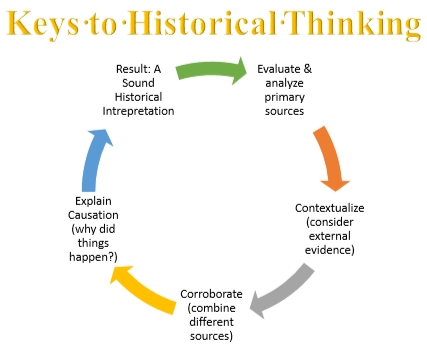adapted by Prof. Slatta from Stanford History Education Group [free registration required for access] You'll find an elaboration of these ideas on this "Reading like a historian" page [PDF] Quick Intro to Historical Thinking and Reading
Thoughts about History from Across the Ages
Quotations about history from an excellent site created by Maxime LagacÚ Additional thoughts on history What is history?
History is an account of the past constructed by a historian based on primary sources (firsthand accounts)..
Accounts differ depending on the source's perspective so we campare and evaluate many different sources..
Using the historical evidence, historians construct an interpretation of of the past.
We question the reliability of each piece of evidence.
Any single piece of evidence is insufficient to build a plausible account, so we use multiple sources. You may find this synthesis matrix helpful. It provides a visual means of organizing historical data.
The historian's job is to explain how and why things happened; to go beyond mere description.

Keys to Historical Thinking & Critical Reading
Historians do not take documents at face value. We are skeptics. We must do a deep reading, a critical reading, to probe beyond surfaces meanings and uncover nuances, subtleties, and possible deceptions in the document.Consider the Source
First step, even before reading the document itself. We don't take sources at face value. Most things are written with one or more goals in mind that can affect their validity and reliability. Critical reading involves asking:
What is the author's perspective?
Why was it written?
When was it written?
Where was it written?
Is this source reliable? Why? Why not?
Evaluate the Source [Close Reading]
Are all historical sources equally trustworthy? How might the reliability of a historical document be affected by the circumstances under which it was created? Evaluation requires a close reading of the source's internal evidence to analyze rhetoric by asking them:
What claims does the author make?
What evidence does the author use?
Is the evidence reliable and valid?
What language (words, phrases, images, symbols) does the author use to persuade the document's audience?
How does the document's language indicate the author's perspective? Contextualize
Locate the document in time and place and analyzing how these factors shaped its content [external evidence]. When reading a document ask:
When and where was the document created?
What was different then? What was the same?
How might the circumstances in which the document was created affect its content?
Corroborate
Consider details across multiple sources to determine points of agreement and disagreement [again, external evidence]. Corroborating documents meanscomparing the document with others and asking:
What do other documents say?
Do the documents agree? If not, why?
What are other possible documents?
What documents are most reliable?
Explain Causation
Read this brief explanation of historical causation [PDF].